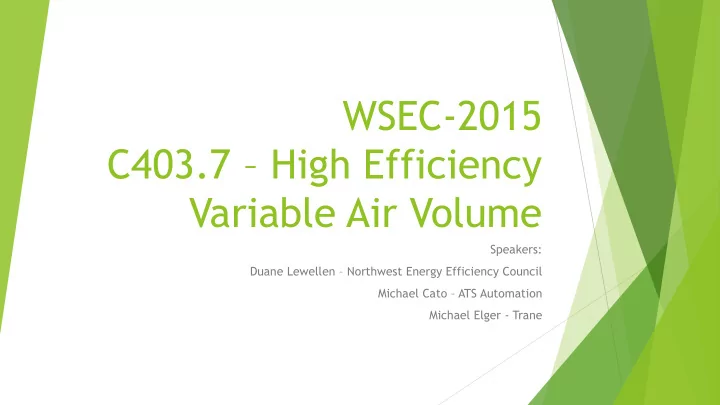

WSEC-2015 C403.7 – High Efficiency Variable Air Volume Speakers: Duane Lewellen – Northwest Energy Efficiency Council Michael Cato – ATS Automation Michael Elger - Trane
C403.7 – High eff VAV systems Effective July 1, 2017 For HVAC systems subject to the requirements of Section C403.6 but utilizing Exception 2 of that section, a high performance VAV system may be provided without a separate parallel DOAS when the system is designed, installed, and configured to comply with all of the following criteria (this exception shall not be used as a substitution for a DOAS per Section C406.6 or as a modification to the requirements for Standard Reference Design per Section C407) Effective July 1, 2017 Must meet all 16 requirements Office, retail, education, libraries and fire stations
What brought us here? A single system is being used for heating, cooling and ventilation – the energy performance is being optimized by paying attention to the following: Fan energy Ventilation energy Reheat energy Central plant efficiency Fault Detection & Diagnostics
Fan Energy Requirement 7 – limits the maximum inlet air duct velocity – air terminal units with a min primary airflow setpoint of 50% or greater of max primary airflow sized with inlet velocity of no greater than 900 fpm Requirement 9 – allowable fan motor hp – not exceed 90% of allowable HVAC fan system bhp Requirement 10 – all fan powered terminal units series or parllel require ECM and terminal units modulate whenever the zone ventilation rates allow turndown
Ventilation Energy Requirement 2 – DDC system required Requirement 3 – multiple zone VAV systems with min OA requirement of 2500 cfm or greater – equipped with device to measure OA intake and system can increase or reduce outdoor airflow based on feedback from VAV terminal units (ASHRAE 62.1 multiple space ventilation equation) Requirement 4 – multiple zone VAV systems with min OA requirement of 2500 cfm or greater – equipped with a device to measure supply airflow to the VAV terminal units Requirement 13 – spaces larger than 150 sq feet and occupant load greater than 25 people per 1000 sq feet must have Dedicated VAV terminal unit to control space temp DCV that uses a CO2 sensor Occupancy sensor
Reheat Energy Requirement 6 – primary max cooling air for the VAV terminal units serving interior cooling load driven zones – sized for supply air temp that is min of 5 deg F greater than the supply air temp for exterior zones in cooling
Central Plant Efficiency Requirement 15 – requires either a high efficiency cooling or heating central plant VAV terminal units with hydronic heating coils connected to systems with hot water generation equipment (gas fired hydronic boilers with thermal eff of 90%+, air-to- water heat pumps or heat recovery chillers) OR Chilled water VAV AHU connected to system with chilled water generation equipment with IPLV values more than 25% higher efficiency than those listed in Table C403.2.3(7)
Fault Detection & Diagnostics – Requirement 16 Requirement 16 – DDC system include FDD to comply with the following: Temp sensors installed (OA, SA, RA) AHU controller configured to provide status of (free cooling available, economizer enabled, compressor enabled, heating enabled, mix air low limit cycle active, current value of each sensor) VAV AHU unit controller capable of manually initiating each operating mode so that the operation of compressors, economizers, fans and heating system can be independently tested and verified VAV AHU unit configured to report faults to a fault management application accessible by day-to-day operating or service personnel or annunciated locally on zone thermostat
Requirement 16 Continued VAV terminal unit configured to report the VAV inlet valve has failed by performance the following diagnostic check at a max interval of once a month Command VAV terminal unit primary air inlet valve closed and verify primary airflow = zero Command VAV terminal unit primary air inlet valve to design airflow and verify that unit is controlling within 10% of design airflow VAV terminal unit configured to report and trend when the zone is driving the AHU reset sequences. Operator can exclude zones used in the reset sequences from the DDC Supply air temp setpoint reset to lowest supply air temp setpoint for cooling Supply air duct static pressure setpoint reset for the highest duct static pressure setpoint allowable
Requirement 16 Continued FDD system configured to detect the following Air temperature sensor failure/fault Not economizing when the unit should be economizer Economizing when the unit should not be economizing Outdoor air or return air damper not modulating Excess outdoor air VAV terminal unit primary air valve failure
Requirement 8 DDC systems designed and configured per the guidelines set by High Performance Sequences of Operation for HVAC Systems (ASHRAE GPC 36, RP- 1455)
Requirement 12 When in occupied heating or in occupied deadband between heating and cooling all fan powered VAV terminal units - configured to reset the primary air supply setpoint – based on VAV air handling unit outdoor air vent fraction, to the min ventilation airflow required per International Mechanical Code
Requirement 14 Dedicated server rooms, electronic equip rooms, telecomm rooms, or similar spaces with cooling loads greater than 5 watts/square foot - provided with separate, independent HVAC systems to allow the VAV AHU to turn off during unoccupied hours EXCEPTION – VAV AHU and VAV terminal units may be used for secondary backup cooling when there is a failure of the primary HVAC system These types of rooms require an airside economizer EXCEPTION – Heat recovery per exception 9 of 403.3 may be in lieu of airside economizer for the independent HVAC system
Recommend
More recommend